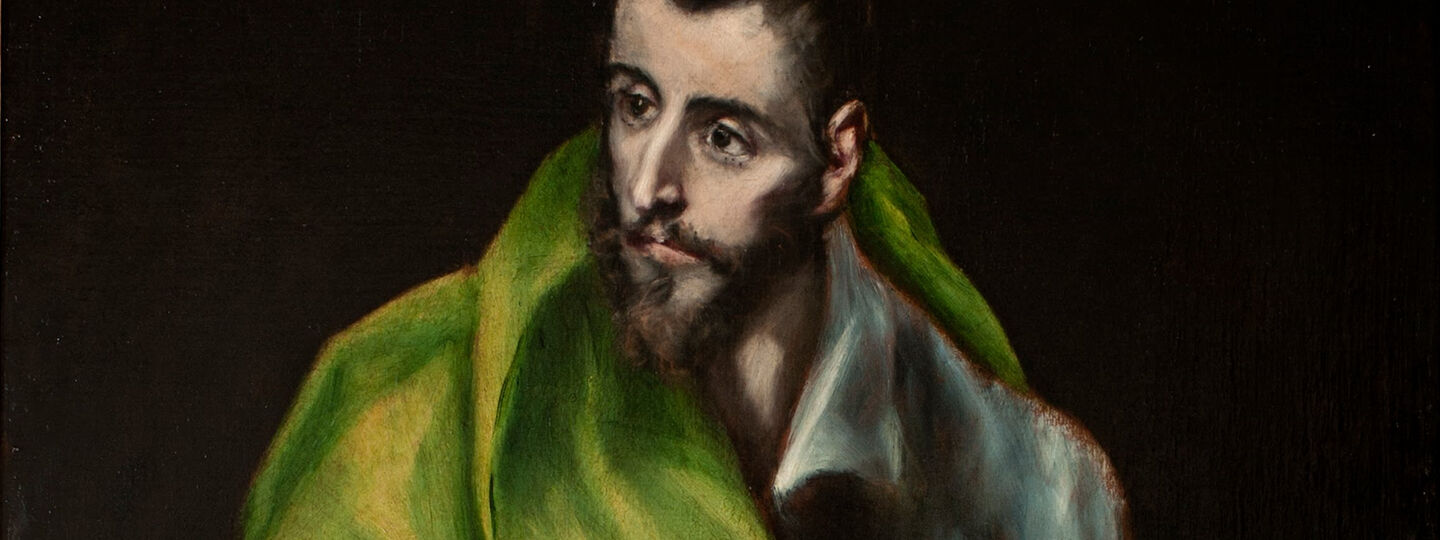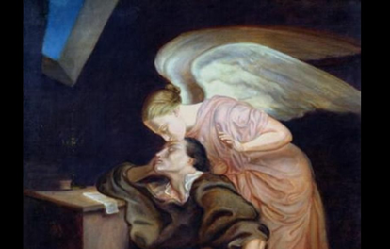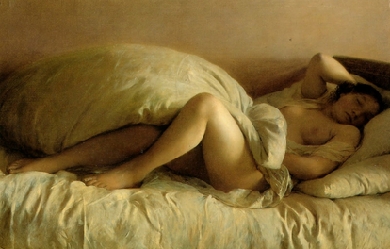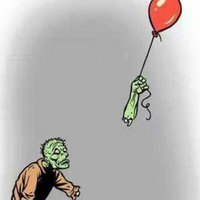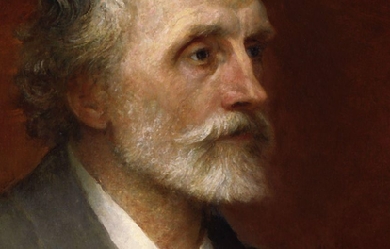
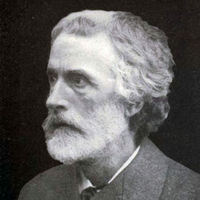
George Meredith, OM (12 February 1828 – 18 May 1909) was an English novelist and poet of the Victorian era. Meredith was born in Portsmouth, England, a son and grandson of naval outfitters. His mother died when he was five. At the age of 14 he was sent to a Moravian School in Neuwied, Germany, where he remained for two years. He read law and was articled as a solicitor, but abandoned that profession for journalism and poetry. He collaborated with Edward Gryffydh Peacock, son of Thomas Love Peacock in publishing a privately circulated literary magazine, the Monthly Observer. He married Edward Peacock's widowed sister Mary Ellen Nicolls in 1849 when he was twenty-one years old and she was twenty-eight. He collected his early writings, first published in periodicals, into Poems, published to some acclaim in 1851. His wife ran off with the English Pre-Raphaelite painter Henry Wallis [1830–1916] in 1858; she died three years later. The collection of "sonnets" entitled Modern Love (1862) came of this experience as did The Ordeal of Richard Feverel, his first "major novel". He married Marie Vulliamy in 1864 and settled in Surrey. He continued writing novels and poetry, often inspired by nature. His writing was characterised by a fascination with imagery and indirect references. He had a keen understanding of comedy and his Essay on Comedy (1877) is still quoted in most discussions of the history of comic theory. In The Egoist, published in 1879, he applies some of his theories of comedy in one of his most enduring novels. Some of his writings, including The Egoist, also highlight the subjugation of women during the Victorian period. During most of his career, he had difficulty achieving popular success. His first truly successful novel was Diana of the Crossways published in 1885. Meredith supplemented his often uncertain writer's income with a job as a publisher's reader. His advice to Chapman and Hall made him influential in the world of letters. His friends in the literary world included, at different times, William and Dante Gabriel Rossetti, Algernon Charles Swinburne, Leslie Stephen, Robert Louis Stevenson, George Gissing and J. M. Barrie. His contemporary Sir Arthur Conan Doyle paid him homage in the short-story The Boscombe Valley Mystery, when Sherlock Holmes says to Dr. Watson during the discussion of the case, "And now let us talk about George Meredith, if you please, and we shall leave all minor matters until to-morrow." Oscar Wilde, in his dialogue The Decay of Lying, implies that Meredith, along with Balzac, is his favourite novelist, saying "Ah, Meredith! Who can define him? His style is chaos illumined by flashes of lightning". In 1868 he was introduced to Thomas Hardy by Frederick Chapman of Chapman & Hall the publishers. Hardy had submitted his first novel, The Poor Man and the Lady. Meredith advised Hardy not to publish his book as it would be attacked by reviewers and destroy his hopes of becoming a novelist. Meredith felt the book was too bitter a satire on the rich and counselled Hardy to put it aside and write another 'with a purely artistic purpose' and more of a plot. Meredith spoke from experience; his first big novel, The Ordeal of Richard Feverel, was judged so shocking that Mudie's circulating library had cancelled an order of 300 copies. Hardy continued to try and publish the novel: however it remained unpublished, though he clearly took Meredith's advice seriously. Before his death, Meredith was honoured from many quarters: he succeeded Lord Tennyson as president of the Society of Authors; in 1905 he was appointed to the Order of Merit by King Edward VII. In 1909, he died at his home in Box Hill, Surrey. Works Essays * Essay on Comedy (1877) Novels * The Shaving of Shagpat (1856) * Farina (1857) * The Ordeal of Richard Feverel (1859) * Evan Harrington (1861) * Emilia in England (1864), republished as Sandra Belloni in 1887 * Rhoda Fleming (1865) * Vittoria (1867) * The Adventures of Harry Richmond (1871) * Beauchamp's Career (1875) * The House on the Beach (1877) * The Case of General Ople and Lady Camper (1877) * The Tale of Chloe (1879) * The Egoist (1879) * The Tragic Comedians (1880) * Diana of the Crossways (1885) * One of our Conquerors (1891) * Lord Ormont and his Aminta (1894) * The Amazing Marriage (1895) * Celt and Saxon (1910) Poetry * Poems (1851) * Modern Love (1862) * Poems and Lyrics of the Joy of Earth (1883) * The Woods of Westermain (1883) * A Faith on Trial (1885) * Ballads and Poems of Tragic Life (1887) * A Reading of Earth (1888) * The Empty Purse (1892) * Odes in Contribution to the Song of French History(1898) * A Reading of Life (1901) * Last Poems (1909) * Lucifer in Starlight * The Lark Ascending (the inspiration for Vaughan Williams' instrumental work The Lark Ascending). References Wikipedia - http://en.wikipedia.org/wiki/George_Meredith

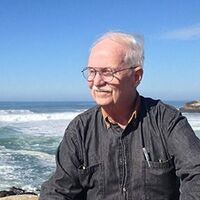
POETRY: * Influenced by the passion and vibrant imagery created by the words of Khalil Gibran, Pablo Neruda, Grace Chacon Leon, Catherine Stanger, Cory Garcia, Nelson Reyes, and J Ann Crowder. * Author of six books; "Wings of Inspiration," "Rhymes of the Joke Machine," "The Air Almighty," "Martin's World," "Secrets of the Wind," and "Mother of Life." (published by Cyberwit.net), Published works in Mature Years, Alive Now, Torrid Literature Journal, Universal Oneness Anthology, Taj Mahal Review, Inkling Magazine, Page & Spine, Charles Carter Anthologies, Purpose Magazine, Terror House Magazine, Brief Wilderness, Cowboy Poetry Press, The Voices Project, Aberration Labyrinth, Long Shot Books, Academy of Hearts & Minds, Blue Lake Review, Gival Press, The Higgs Weldon, Funny In Five Hundred, Verse-Virtual, Wilderness House Literary Review, White Liquor Mag, Ygdrasil Literary Journal, Poetica, Green Silk Journal, Madswirl, Lyrical Passion Poetry E-Zine, Poet's Pen, Storyteller, FreeXpression, Poets' Espresso, Long Story Short, Oddball Magazine, Asinine Poetry, Write On!!, American Legion On-Line, Pegasus Review, Prayerworks, Stepping Stones, Love's Chance, Poet's Haven, Jerry Jazz Musician, Fullosia Press, The Sheltered Poet, The Belt and Beyond, Blue Minaret, and Ego Phobia. * Wrote two chapbooks entitled "In Reverence to Life" and "A Sage's Diary," (published by In His Steps Publishing). Won two poetry awards (Faith and Hope) and appeared in many anthology books. MUSIC: * Playing, writing, and arranging music for most of life. * Studied music at Westlake College of Music in Hollywood, California in 1958 and majored in piano. * Played in the 82nd Army Band in Stuttgard, Germany from 1962 until 1964. * Played in the Jimmy Dorsey Band in 1965. * Played in a band in Bergen, Norway in 1966. * Composed score for Dr. Ira Cochin's Rally George in Valley Forge children's play. * Playing the organ at 1st Methodist Church in Wind Gap, PA for the past thirty years... THE REST OF LIFE: Born in Ashtabula, Ohio, and moved to New York City shortly thereafter. Got married in 1984 and had a wonderful daughter in 1985. Can be found at his home in Bangor, PA at his keyboard, or in front of a yellow legal pad, pen in hand...
_and_brother_Ronald_-_Google_Art_Project.jpg)
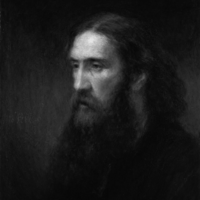
George MacDonald (10 December 1824– 18 September 1905) was a Scottish author, poet, and Christian minister. He was a pioneering figure in the field of fantasy literature and the mentor of fellow writer Lewis Carroll. His writings have been cited as a major literary influence by many notable authors including W. H. Auden, C. S. Lewis, J. R. R. Tolkien, Walter de la Mare, E. Nesbit and Madeleine L’Engle. C. S. Lewis wrote that he regarded MacDonald as his “master”: “Picking up a copy of Phantastes one day at a train-station bookstall, I began to read. A few hours later,” said Lewis, “I knew that I had crossed a great frontier.” G. K. Chesterton cited The Princess and the Goblin as a book that had “made a difference to my whole existence”. Elizabeth Yates wrote of Sir Gibbie, “It moved me the way books did when, as a child, the great gates of literature began to open and first encounters with noble thoughts and utterances were unspeakably thrilling.” Even Mark Twain, who initially disliked MacDonald, became friends with him, and there is some evidence that Twain was influenced by MacDonald. Christian author Oswald Chambers (1874–1917) wrote in Christian Disciplines, vol. 1, (pub. 1934) that “it is a striking indication of the trend and shallowness of the modern reading public that George MacDonald’s books have been so neglected”. In addition to his fairy tales, MacDonald wrote several works on Christian apologetics including several that defended his view of Christian Universalism. Early life George MacDonald was born on 10 December 1824 at Huntly, Aberdeenshire, Scotland. His father, a farmer, was one of the MacDonalds of Glen Coe, and a direct descendant of one of the families that suffered in the massacre of 1692. The Doric dialect of the Aberdeenshire area appears in the dialogue of some of his non-fantasy novels. MacDonald grew up in the Congregational Church, with an atmosphere of Calvinism. But MacDonald never felt comfortable with some aspects of Calvinist doctrine; indeed, legend has itt that when the doctrine of predestination was first explained to him, he burst into tears (although assured that he was one of the elect). Later novels, such as Robert Falconer and Lilith, show a distaste for the idea that God’s electing love is limited to some and denied to others. MacDonald graduated from the University of Aberdeen, and then went to London, studying at Highbury College for the Congregational ministry. In 1850 he was appointed pastor of Trinity Congregational Church, Arundel, but his sermons (preaching God’s universal love and the possibility that none would, ultimately, fail to unite with God) met with little favour and his salary was cut in half. Later he was engaged in ministerial work in Manchester. He left that because of poor health, and after a short sojourn in Algiers he settled in London and taught for some time at the University of London. MacDonald was also for a time editor of Good Words for the Young, and lectured successfully in the United States during 1872–1873. Work George MacDonald’s best-known works are Phantastes, The Princess and the Goblin, At the Back of the North Wind, and Lilith, all fantasy novels, and fairy tales such as “The Light Princess”, “The Golden Key”, and “The Wise Woman”. “I write, not for children,” he wrote, “but for the child-like, whether they be of five, or fifty, or seventy-five.” MacDonald also published some volumes of sermons, the pulpit not having proved an unreservedly successful venue. MacDonald also served as a mentor to Lewis Carroll (the pen-name of Rev. Charles Lutwidge Dodgson); it was MacDonald’s advice, and the enthusiastic reception of Alice by MacDonald’s many sons and daughters, that convinced Carroll to submit Alice for publication. Carroll, one of the finest Victorian photographers, also created photographic portraits of several of the MacDonald children. MacDonald was also friends with John Ruskin and served as a go-between in Ruskin’s long courtship with Rose La Touche. MacDonald was acquainted with most of the literary luminaries of the day; a surviving group photograph shows him with Tennyson, Dickens, Wilkie Collins, Trollope, Ruskin, Lewes, and Thackeray. While in America he was a friend of Longfellow and Walt Whitman. In 1877 he was given a civil list pension. From 1879 he and his family moved to Bordighera in a place much loved by British expatriates, the Riviera dei Fiori in Liguria, Italy, almost on the French border. In that locality there also was an Anglican Church, which he attended. Deeply enamoured of the Riviera, he spent there 20 years, writing almost half of his whole literary production, especially the fantasy work. In that Ligurian town MacDonald founded a literary studio named Casa Coraggio (Bravery House), which soon became one of the most renowned cultural centres of that period, well attended by British and Italian travellers, and by locals. In that house representations were often held of classic plays, and readings were given of Dante and Shakespeare. In 1900 he moved into St George’s Wood, Haslemere, a house designed for him by his son, Robert Falconer MacDonald, and the building overseen by his eldest son, Greville MacDonald. He died on 18 September 1905 in Ashtead, (Surrey). He was cremated and his ashes buried in Bordighera, in the English cemetery, along with his wife Louisa and daughters Lilia and Grace. As hinted above, MacDonald’s use of fantasy as a literary medium for exploring the human condition greatly influenced a generation of such notable authors as C. S. Lewis (who featured him as a character in his The Great Divorce), J. R. R. Tolkien, and Madeleine L’Engle. MacDonald’s non-fantasy novels, such as Alec Forbes, had their influence as well; they were among the first realistic Scottish novels, and as such MacDonald has been credited with founding the “kailyard school” of Scottish writing. His son Greville MacDonald became a noted medical specialist, a pioneer of the Peasant Arts movement, and also wrote numerous fairy tales for children. Greville ensured that new editions of his father’s works were published. Another son, Ronald MacDonald, was also a novelist. Ronald’s son, Philip MacDonald, (George MacDonald’s grandson) became a very well known Hollywood screenwriter. Theology MacDonald rejected the doctrine of penal substitutionary atonement as developed by John Calvin, which argues that Christ has taken the place of sinners and is punished by the wrath of God in their place, believing that in turn it raised serious questions about the character and nature of God. Instead, he taught that Christ had come to save people from their sins, and not from a Divine penalty for their sins. The problem was not the need to appease a wrathful God but the disease of cosmic evil itself. George MacDonald frequently described the Atonement in terms similar to the Christus Victor theory. MacDonald posed the rhetorical question, “Did he not foil and slay evil by letting all the waves and billows of its horrid sea break upon him, go over him, and die without rebound—spend their rage, fall defeated, and cease? Verily, he made atonement!” MacDonald was convinced that God does not punish except to amend, and that the sole end of His greatest anger is the amelioration of the guilty. As the doctor uses fire and steel in certain deep-seated diseases, so God may use hell-fire if necessary to heal the hardened sinner. MacDonald declared, “I believe that no hell will be lacking which would help the just mercy of God to redeem his children.” MacDonald posed the rhetorical question, “When we say that God is Love, do we teach men that their fear of Him is groundless?” He replied, “No. As much as they fear will come upon them, possibly far more.... The wrath will consume what they call themselves; so that the selves God made shall appear.” However, true repentance, in the sense of freely chosen moral growth, is essential to this process, and, in MacDonald’s optimistic view, inevitable for all beings (see universal reconciliation). He recognised the theoretical possibility that, bathed in the eschatological divine light, some might perceive right and wrong for what they are but still refuse to be transfigured by operation of God’s fires of love, but he did not think this likely. In this theology of divine punishment, MacDonald stands in opposition to Augustine of Hippo, and in agreement with the Greek Church Fathers Clement of Alexandria, Origen, and St. Gregory of Nyssa, although it is unknown whether MacDonald had a working familiarity with Patristics or Eastern Orthodox Christianity. At least an indirect influence is likely, because F. D. Maurice, who influenced MacDonald, knew the Greek Fathers, especially Clement, very well. MacDonald states his theological views most distinctly in the sermon Justice found in the third volume of Unspoken Sermons. In his introduction to George MacDonald: An Anthology, C. S. Lewis speaks highly of MacDonald’s theology: “This collection, as I have said, was designed not to revive MacDonald’s literary reputation but to spread his religious teaching. Hence most of my extracts are taken from the three volumes of Unspoken Sermons. My own debt to this book is almost as great as one man can owe to another: and nearly all serious inquirers to whom I have introduced it acknowledge that it has given them great help—sometimes indispensable help toward the very acceptance of the Christian faith. ... I know hardly any other writer who seems to be closer, or more continually close, to the Spirit of Christ Himself. Hence his Christ-like union of tenderness and severity. Nowhere else outside the New Testament have I found terror and comfort so intertwined.... In making this collection I was discharging a debt of justice. I have never concealed the fact that I regarded him as my master; indeed I fancy I have never written a book in which I did not quote from him. But it has not seemed to me that those who have received my books kindly take even now sufficient notice of the affiliation. Honesty drives me to emphasize it.” Bibliography Fantasy * Phantastes: A Fairie Romance for Men and Women (1858) * “Cross Purposes” (1862) * Adela Cathcart (1864), containing “The Light Princess”, “The Shadows”, and other short stories * The Portent: A Story of the Inner Vision of the Highlanders, Commonly Called “The Second Sight” (1864) * Dealings with the Fairies (1867), containing “The Golden Key”, “The Light Princess”, “The Shadows”, and other short stories * At the Back of the North Wind (1871) * Works of Fancy and Imagination (1871), including Within and Without, “Cross Purposes”, “The Light Princess”, “The Golden Key”, and other works * The Princess and the Goblin (1872) * The Wise Woman: A Parable (1875) (Published also as “The Lost Princess: A Double Story”; or as “A Double Story”.) * The Gifts of the Child Christ and Other Tales (1882; republished as Stephen Archer and Other Tales) * The Day Boy and the Night Girl (1882) * The Princess and Curdie (1883), a sequel to The Princess and the Goblin * The Flight of the Shadow (1891) * Lilith: A Romance (1895) Realistic fiction * David Elginbrod (1863; republished as The Tutor’s First Love), originally published in three volumes * Alec Forbes of Howglen (1865; republished as The Maiden’s Bequest) * Annals of a Quiet Neighbourhood (1867) * Guild Court: A London Story (1868) * Robert Falconer (1868; republished as The Musician’s Quest) * The Seaboard Parish (1869), a sequel to Annals of a Quiet Neighbourhood * Ranald Bannerman’s Boyhood (1871) * Wilfrid Cumbermede (1871–72) * The Vicar’s Daughter (1871–72), a sequel to Annals of a Quiet Neighborhood and The Seaboard Parish * The History of Gutta Percha Willie, the Working Genius (1873), usually called simply Gutta Percha Willie * Malcolm (1875) * St. George and St. Michael (1876) * Thomas Wingfold, Curate (1876; republished as The Curate’s Awakening) * The Marquis of Lossie (1877; republished as The Marquis’ Secret), the second book of Malcolm * Paul Faber, Surgeon (1879; republished as The Lady’s Confession), a sequel to Thomas Wingfold, Curate * Sir Gibbie (1879; republished as The Baronet’s Song) * Mary Marston (1881; republished as A Daughter’s Devotion) * Warlock o’ Glenwarlock (1881; republished as Castle Warlock and The Laird’s Inheritance) * Weighed and Wanting (1882; republished as A Gentlewoman’s Choice) * Donal Grant (1883; republished as The Shepherd’s Castle), a sequel to Sir Gibbie * What’s Mine’s Mine (1886; republished as The Highlander’s Last Song) * Home Again: A Tale (1887; republished as The Poet’s Homecoming) * The Elect Lady (1888; republished as The Landlady’s Master) * A Rough Shaking (1891) * There and Back (1891; republished as The Baron’s Apprenticeship), a sequel to Thomas Wingfold, Curate and Paul Faber, Surgeon * Heather and Snow (1893; republished as The Peasant Girl’s Dream) * Salted with Fire (1896; republished as The Minister’s Restoration) * Far Above Rubies (1898) Poetry * Twelve of the Spiritual Songs of Novalis (1851), privately printed translation of the poetry of Novalis * Within and Without: A Dramatic Poem (1855) * Poems (1857) * “A Hidden Life” and Other Poems (1864) * “The Disciple” and Other Poems (1867) * Exotics: A Translation of the Spiritual Songs of Novalis, the Hymn-book of Luther, and Other Poems from the German and Italian (1876) * Dramatic and Miscellaneous Poems (1876) * Diary of an Old Soul (1880) * A Book of Strife, in the Form of the Diary of an Old Soul (1880), privately printed * The Threefold Cord: Poems by Three Friends (1883), privately printed, with Greville Matheson and John Hill MacDonald * Poems (1887) * The Poetical Works of George MacDonald, 2 Volumes (1893) * Scotch Songs and Ballads (1893) * Rampolli: Growths from a Long-planted Root (1897) Nonfiction * Unspoken Sermons (1867) * England’s Antiphon (1868, 1874) * The Miracles of Our Lord (1870) * Cheerful Words from the Writing of George MacDonald (1880), compiled by E. E. Brown * Orts: Chiefly Papers on the Imagination, and on Shakespeare (1882) * “Preface” (1884) to Letters from Hell (1866) by Valdemar Adolph Thisted * The Tragedie of Hamlet, Prince of Denmarke: A Study With the Test of the Folio of 1623 (1885) * Unspoken Sermons, Second Series (1885) * Unspoken Sermons, Third Series (1889) * A Cabinet of Gems, Cut and Polished by Sir Philip Sidney; Now, for the More Radiance, Presented Without Their Setting by George MacDonald (1891) * The Hope of the Gospel (1892) * A Dish of Orts (1893) * Beautiful Thoughts from George MacDonald (1894), compiled by Elizabeth Dougall In popular culture * (Alphabetical by artist) * Christian celtic punk band Ballydowse have a song called “George MacDonald” on their album Out of the Fertile Crescent. The song is both taken from MacDonald’s poem “My Two Geniuses” and liberally quoted from Phantastes. * American classical composer John Craton has utilized several of MacDonald’s stories in his works, including “The Gray Wolf” (in a tone poem of the same name for solo mandolin– 2006) and portions of “The Cruel Painter”, Lilith, and The Light Princess (in Three Tableaux from George MacDonald for mandolin, recorder, and cello– 2011). * Contemporary new-age musician Jeff Johnson wrote a song titled “The Golden Key” based on George MacDonald’s story of the same name. He has also written several other songs inspired by MacDonald and the Inklings. * Jazz pianist and recording artist Ray Lyon has a song on his CD Beginning to See (2007), called “Up The Spiral Stairs”, which features lyrics from MacDonald’s 26 and 27 September devotional readings from the book Diary of an Old Soul. * A verse from The Light Princess is cited in the “Beauty and the Beast” song by Nightwish. * Rock group The Waterboys titled their album Room to Roam (1990) after a passage in MacDonald’s Phantastes, also found in Lilith. The title track of the album comprises a MacDonald poem from the text of Phantastes set to music by the band. The novels Lilith and Phantastes are both named as books in a library, in the title track of another Waterboys album, Universal Hall (2003). (The Waterboys have also quoted from C. S. Lewis in several songs, including “Church Not Made With Hands” and “Further Up, Further In”, confirming the enduring link in modern pop culture between MacDonald and Lewis.) References Wikipedia—https://en.wikipedia.org/wiki/George_MacDonald

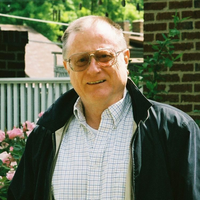
Donal Mahoney, a native of Chicago, lives in St. Louis, Missouri. His fiction and poetry have appeared in various publications, including The Wisconsin Review, The Kansas Quarterly, The South Carolina Review, The Christian Science Monitor, The Beloit Poetry Journal, Commonweal, The Galway Review (Ireland), Public Republic (Bulgaria), Revival (Ireland), The Istanbul Literary Review (Turkey) and other magazines. Some of his earliest work can be found at http://booksonblog12.blogspot.com; some newer work at http://eyeonlifemag.com/the-poetry-locksmith/donal-mahoney-poet.html#sthash.OSYzpgmQ.dpbs=
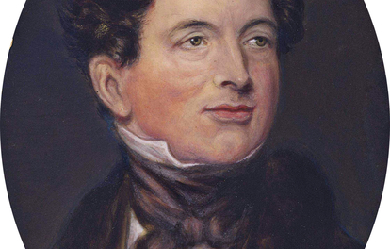
.jpeg)
Thomas Moore (28 May 1779 – 25 February 1852), also known as Tom Moore, was an Irish writer, poet, and lyricist celebrated for his Irish Melodies. His setting of English-language verse to old Irish tunes marked the transition in popular Irish culture from Irish to English. Politically, Moore was recognised in England as a press, or "squib", writer for the aristocratic Whigs; in Ireland he was accounted a Catholic patriot.

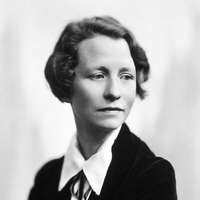
Edna St. Vincent Millay (February 22, 1892 – October 19, 1950) was an American poet and playwright. She received the Pulitzer Prize for Poetry in 1923, the third woman to win the award for poetry, and was also known for her feminist activism. She used the pseudonym Nancy Boyd for her prose work. The poet Richard Wilbur asserted, "She wrote some of the best sonnets of the century."
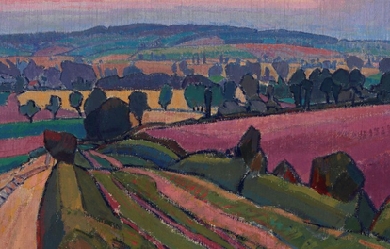
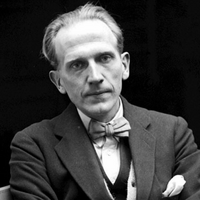
Alan Alexander “A. A.” Milne (/ˈmɪln/; 18 January 1882– 31 January 1956) was an English author, best known for his books about the teddy bear Winnie-the-Pooh and for various poems. Milne was a noted writer, primarily as a playwright, before the huge success of Pooh overshadowed all his previous work. Milne served in both World Wars, joining the British Army in World War I, and was a captain of the British Home Guard in World War II. Biography Alan Alexander Milne was born in Kilburn, London to parents John Vince Milne, who was Scottish, and Sarah Marie Milne (née Heginbotham) and grew up at Henley House School, 6/7 Mortimer Road (now Crescent), Kilburn, a small public school run by his father. One of his teachers was H. G. Wells, who taught there in 1889–90. Milne attended Westminster School and Trinity College, Cambridge where he studied on a mathematics scholarship, graduating with a B.A. in Mathematics in 1903. While there, he edited and wrote for Granta, a student magazine. He collaborated with his brother Kenneth and their articles appeared over the initials AKM. Milne’s work came to the attention of the leading British humour magazine Punch, where Milne was to become a contributor and later an assistant editor. Milne played for the amateur English cricket team the Allahakbarries alongside authors J. M. Barrie and Arthur Conan Doyle. Milne joined the British Army in World War I and served as an officer in the Royal Warwickshire Regiment and later, after a debilitating illness, the Royal Corps of Signals. He was commissioned into the 4th Battalion, Royal Warwickshire Regiment on 17 February 1915 as a second lieutenant (on probation). His commission was confirmed on 20 December 1915. On 7 July 1916, he was injured while serving in the Battle of the Somme and invalided back to England. Having recuperated, he was recruited into Military Intelligence to write propaganda articles for MI 7b between 1916 and 1918. He was discharged on 14 February 1919, and settled in Mallord Street, Chelsea. He relinquished his commission on 19 February 1920, retaining the rank of lieutenant. After the war, he wrote a denunciation of war titled Peace with Honour (1934), which he retracted somewhat with 1940's War with Honour. During World War II, Milne was one of the most prominent critics of fellow English writer P. G. Wodehouse, who was captured at his country home in France by the Nazis and imprisoned for a year. Wodehouse made radio broadcasts about his internment, which were broadcast from Berlin. Although the light-hearted broadcasts made fun of the Germans, Milne accused Wodehouse of committing an act of near treason by cooperating with his country’s enemy. Wodehouse got some revenge on his former friend (e.g., in The Mating Season) by creating fatuous parodies of the Christopher Robin poems in some of his later stories, and claiming that Milne “was probably jealous of all other writers.... But I loved his stuff.” Milne married Dorothy “Daphne” de Sélincourt in 1913 and their son Christopher Robin Milne was born in 1920. In 1925, A. A. Milne bought a country home, Cotchford Farm, in Hartfield, East Sussex. During World War II, A. A. Milne was Captain of the British Home Guard in Hartfield & Forest Row, insisting on being plain “Mr. Milne” to the members of his platoon. He retired to the farm after a stroke and brain surgery in 1952 left him an invalid, and by August 1953 “he seemed very old and disenchanted”. Milne died in January 1956, aged 74. Literary career 1903 to 1925 After graduating from Cambridge in 1903, A. A. Milne contributed humorous verse and whimsical essays to Punch, joining the staff in 1906 and becoming an assistant editor. During this period he published 18 plays and 3 novels, including the murder mystery The Red House Mystery (1922). His son was born in August 1920 and in 1924 Milne produced a collection of children’s poems When We Were Very Young, which were illustrated by Punch staff cartoonist E. H. Shepard. A collection of short stories for children Gallery of Children, and other stories that became part of the Winnie-the-Pooh books, were first published in 1925. Milne was an early screenwriter for the nascent British film industry, writing four stories filmed in 1920 for the company Minerva Films (founded in 1920 by the actor Leslie Howard and his friend and story editor Adrian Brunel). These were The Bump, starring Aubrey Smith; Twice Two; Five Pound Reward; and Bookworms. Some of these films survive in the archives of the British Film Institute. Milne had met Howard when the actor starred in Milne’s play Mr Pim Passes By in London. Looking back on this period (in 1926), Milne observed that when he told his agent that he was going to write a detective story, he was told that what the country wanted from a “Punch humorist” was a humorous story; when two years later he said he was writing nursery rhymes, his agent and publisher were convinced he should write another detective story; and after another two years, he was being told that writing a detective story would be in the worst of taste given the demand for children’s books. He concluded that “the only excuse which I have yet discovered for writing anything is that I want to write it; and I should be as proud to be delivered of a Telephone Directory con amore as I should be ashamed to create a Blank Verse Tragedy at the bidding of others.” 1926 to 1928 Milne is most famous for his two Pooh books about a boy named Christopher Robin after his son, Christopher Robin Milne, and various characters inspired by his son’s stuffed animals, most notably the bear named Winnie-the-Pooh. Christopher Robin Milne’s stuffed bear, originally named “Edward”, was renamed “Winnie-the-Pooh” after a Canadian black bear named Winnie (after Winnipeg), which was used as a military mascot in World War I, and left to London Zoo during the war. “The pooh” comes from a swan called “Pooh”. E. H. Shepard illustrated the original Pooh books, using his own son’s teddy, Growler ("a magnificent bear"), as the model. The rest of Christopher Robin Milne’s toys, Piglet, Eeyore, Kanga, Roo and Tigger, were incorporated into A. A. Milne’s stories, and two more characters– Rabbit and Owl– were created by Milne’s imagination. Christopher Robin Milne’s own toys are now under glass in New York where 750,000 people visit them every year. The fictional Hundred Acre Wood of the Pooh stories derives from Five Hundred Acre Wood in Ashdown Forest in East Sussex, South East England, where the Pooh stories were set. Milne lived on the northern edge of the forest at Cotchford Farm, 51.090°N 0.107°E / 51.090; 0.107, and took his son walking there. E. H. Shepard drew on the landscapes of Ashdown Forest as inspiration for many of the illustrations he provided for the Pooh books. The adult Christopher Robin commented: “Pooh’s Forest and Ashdown Forest are identical”. Popular tourist locations at Ashdown Forest include: Galleon’s Lap, The Enchanted Place, the Heffalump Trap and Lone Pine, Eeyore’s Sad and Gloomy Place, and the wooden Pooh Bridge where Pooh and Piglet invented Poohsticks. Not yet known as Pooh, he made his first appearance in a poem, “Teddy Bear”, published in Punch magazine in February 1924. Pooh first appeared in the London Evening News on Christmas Eve, 1925, in a story called “The Wrong Sort Of Bees”. Winnie-the-Pooh was published in 1926, followed by The House at Pooh Corner in 1928. A second collection of nursery rhymes, Now We Are Six, was published in 1927. All three books were illustrated by E. H. Shepard. Milne also published four plays in this period. He also “gallantly stepped forward” to contribute a quarter of the costs of dramatising P. G. Wodehouse’s A Damsel in Distress. The World of Pooh won the Lewis Carroll Shelf Award in 1958. 1929 onwards The success of his children’s books was to become a source of considerable annoyance to Milne, whose self-avowed aim was to write whatever he pleased and who had, until then, found a ready audience for each change of direction: he had freed pre-war Punch from its ponderous facetiousness; he had made a considerable reputation as a playwright (like his idol J. M. Barrie) on both sides of the Atlantic; he had produced a witty piece of detective writing in The Red House Mystery (although this was severely criticised by Raymond Chandler for the implausibility of its plot). But once Milne had, in his own words, "said goodbye to all that in 70,000 words" (the approximate length of his four principal children’s books), he had no intention of producing any reworkings lacking in originality, given that one of the sources of inspiration, his son, was growing older. In his literary home, Punch, where the When We Were Very Young verses had first appeared, Methuen continued to publish whatever Milne wrote, including the long poem “The Norman Church” and an assembly of articles entitled Year In, Year Out (which Milne likened to a benefit night for the author). In 1930, Milne adapted Kenneth Grahame’s novel The Wind in the Willows for the stage as Toad of Toad Hall. The title was an implicit admission that such chapters as Chapter 7, “The Piper at the Gates of Dawn”, could not survive translation to the theatre. A special introduction written by Milne is included in some editions of Grahame’s novel. Legacy and commemoration The rights to A. A. Milne’s Pooh books were left to four beneficiaries: his family, the Royal Literary Fund, Westminster School and the Garrick Club. After Milne’s death in 1956, one week and six days after his 74th birthday, his widow sold her rights to the Pooh characters to Stephen Slesinger, whose widow sold the rights after Slesinger’s death to the Walt Disney Company, which has made many Pooh cartoon movies, a Disney Channel television show, as well as Pooh-related merchandise. In 2001, the other beneficiaries sold their interest in the estate to the Disney Corporation for $350m. Previously Disney had been paying twice-yearly royalties to these beneficiaries. The estate of E. H. Shepard also received a sum in the deal. The copyright on Pooh expires in 2026. In 2008, a collection of original illustrations featuring Winnie-the-Pooh and his animal friends sold for more than £1.2 million at auction in Sotheby’s, London. Forbes magazine ranked Winnie the Pooh the most valuable fictional character in 2002; Winnie the Pooh merchandising products alone had annual sales of more than $5.9 billion. In 2005, Winnie the Pooh generated $6 billion, a figure surpassed by only Mickey Mouse. A memorial plaque in Ashdown Forest, unveiled by Christopher Robin in 1979, commemorates the work of A. A. Milne and Shepard in creating the world of Pooh. Milne once wrote of Ashdown Forest: “In that enchanted place on the top of the forest a little boy and his bear will always be playing”. In 2003, Winnie the Pooh was listed at number 7 on the BBC’s survey The Big Read. In 2006, Winnie the Pooh received a star on the Hollywood Walk of Fame, marking the 80th birthday of Milne’s creation. That same year a UK poll saw Winnie the Pooh voted onto the list of icons of England. Several of Milne’s children’s poems were set to music by the composer Harold Fraser-Simson. His poems have been parodied many times, including with the books When We Were Rather Older and Now We Are Sixty. The 1963 film The King’s Breakfast was based on Milne’s poem of the same name. Religious views Milne did not speak out much on the subject of religion, although he used religious terms to explain his decision, while remaining a pacifist, to join the British Home Guard: “In fighting Hitler”, he wrote, “we are truly fighting the Devil, the Anti-Christ... Hitler was a crusader against God.” His best known comment on the subject was recalled on his death: The Old Testament is responsible for more atheism, agnosticism, disbelief—call it what you will—than any book ever written; it has emptied more churches than all the counter-attractions of cinema, motor bicycle and golf course. He also wrote the poem “Explained”: Works Novels * Lovers in London (1905. Some consider this more of a short story collection; Milne did not like it and considered The Day’s Play as his first book.) * Once on a Time (1917) * Mr. Pim (1921) (A novelisation of his play Mr. Pim Passes By (1919)) * The Red House Mystery (1922) * Two People (1931) (Inside jacket claims this is Milne’s first attempt at a novel.) * Four Days’ Wonder (1933) * Chloe Marr (1946) Non-fiction * Peace With Honour (1934) * It’s Too Late Now: The Autobiography of a Writer (1939) * War With Honour (1940) * War Aims Unlimited (1941) * Year In, Year Out (1952) (illustrated by E. H. Shepard) Punch articles * The Day’s Play (1910) * Once A Week (1914) * The Holiday Round (1912) * The Sunny Side (1921) * Those Were the Days (1929) [The four volumes above, compiled] Newspaper articles and book introductions * The Chronicles of Clovis by “Saki” (1911) [Introduction to] * Not That It Matters (1920) * By Way of Introduction (1929) Story collections for children * A Gallery of Children (1925) * Winnie-the-Pooh (1926) (illustrated by Ernest H. Shepard) * The House at Pooh Corner (1928) (illustrated by E. H. Shepard) * Short Stories Poetry collections for children * When We Were Very Young (1924) (illustrated by E. H. Shepard) * Now We Are Six (1927) (illustrated by E. H. Shepard) Story collections * The Secret and other stories (1929) * The Birthday Party (1948) * A Table Near the Band (1950) Poetry * For the Luncheon Interval [poems from Punch] * When We Were Very Young (1924) (illustrated by E. H. Shepard) * Now We Are Six (1927) (illustrated by E. H. Shepard) * Behind the Lines (1940) * The Norman Church (1948) * “The Knight Whose Armor Didn’t Squeak” Screenplays and plays * Wurzel-Flummery (1917) * Belinda (1918) * The Boy Comes Home (1918) * Make-Believe (1918) (children’s play) * The Camberley Triangle (1919) * Mr. Pim Passes By (1919) * The Red Feathers (1920) * The Bump (1920, Minerva Films), starring Aubrey Smith * Twice Two (1920, Minerva Films) * Five Pound Reward (1920, Minerva Films) * Bookworms (1920, Minerva Films) * The Great Broxopp (1921) * The Dover Road (1921) * The Lucky One (1922) * The Truth About Blayds (1922) * The Artist: A Duologue (1923) * Give Me Yesterday (1923) (a.k.a. Success in the UK) * Ariadne (1924) * The Man in the Bowler Hat: A Terribly Exciting Affair (1924) * To Have the Honour (1924) * Portrait of a Gentleman in Slippers (1926) * Success (1926) * Miss Marlow at Play (1927) * The Fourth Wall or The Perfect Alibi (1928) (later adapted for the film Birds of Prey (1930), directed by Basil Dean) * The Ivory Door (1929) * Toad of Toad Hall (1929) (adaptation of The Wind in the Willows) * Michael and Mary (1930) * Other People’s Lives (1933) (a.k.a. They Don’t Mean Any Harm) * Miss Elizabeth Bennet (1936) [based on Pride and Prejudice] * Sarah Simple (1937) * Gentleman Unknown (1938) * The General Takes Off His Helmet (1939) in The Queen’s Book of the Red Cross * The Ugly Duckling (1941) * Before the Flood (1951). References Wikipedia—https://en.wikipedia.org/wiki/A._A._Milne
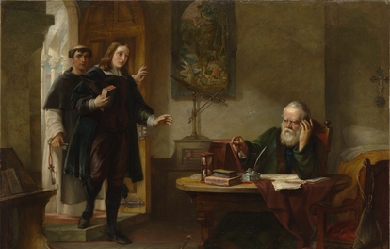
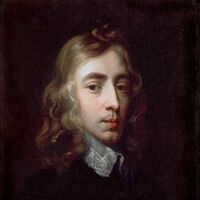
John Milton (9 December 1608 – 8 November 1674) was an English poet, polemicist, a scholarly man of letters, and a civil servant for the Commonwealth (republic) of England under Oliver Cromwell. He wrote at a time of religious flux and political upheaval, and is best known for his epic poem Paradise Lost. Milton's poetry and prose reflect deep personal convictions, a passion for freedom and self determination, and the urgent issues and political turbulence of his day. Writing in English, Latin, and Italian, he achieved international renown within his lifetime, and his celebrated Areopagitica, (written in condemnation of pre-publication censorship) is among history’s most influential and impassioned defenses of free speech and freedom of the press.
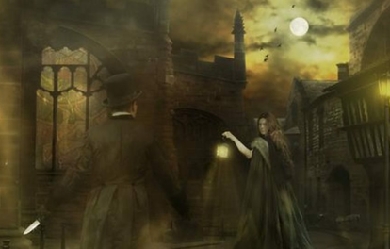

I am an enthusiastic scholar of American, Irish, and English history, Victorian literature, myths, legends, folklore, and Pagan religions. My prose and poetry are generally Gothic in theme and usually set in historical periods. My favourite authors are Edgar Allen Poe, Samuel Clemens, Charles Dickens, Henry James, Sir Arthur Conan Doyle, H.P. Lovecraft, M. R. James, Washington Irving, and Oscar Wilde, just to name a few, and my favourite poets are Keats, Byron, Yeats, Wordsworth, Tennyson, and Longfellow. I have three books of poetry currently on the market, three Gothic novels, one anthology of six horror stories, and several novellas and novelettes. I was raised in Wheatridge, Colorado and attended The University of Colorado at Denver. I currently live in Corvallis, Montana in the great Pacific Northwest.
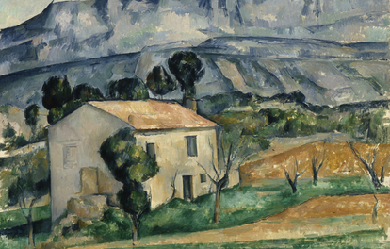
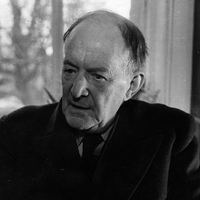
Walter John de la Mare (25 April 1873– 22 June 1956) was an English poet, short story writer and novelist. He is probably best remembered for his works for children, for his poem “The Listeners”, and for subtle psychological horror stories, amongst them “Seaton’s Aunt” and “Out of the Deep”. His 1921 novel Memoirs of a Midget won the James Tait Black Memorial Prize for fiction, and his post-war Collected Stories for Children won the 1947 Carnegie Medal for British children’s books.

I'm a teenage experimental poet, song writer, and author. I come from a good home but a not so good past. I explain myself through poetry and writing, because there is no other way to described me. I'm just awkward. I have severe depression and anxiety, along with other problems and struggles, and writing helps ease it all. I have love and passion for my work, and I plan on becoming a published author in the future. I try to use all senses of perspective in my writing; I wish to help change the world one poem at a time. ***PLEASE DO NOT COPYRIGHT WHAT IS PUBLISHED ON THIS BLOG. ONLY SHARE UNDER MY NAME AND ESTABLISH CORRECT OWNERSHIP. I CLAIM THESE WORKS AS MY OWN AND UNDER NO CIRCUMSTANCES SHOULD I BE BLAMED FOR FRAUD, OR HAVE PERSONS DENY ME MY RIGHTS BECAUSE OF MY AGE AND SOCIAL STANDING. MY WRITINGS, MY NAME, MY STORY, MY RIGHT. PLEASE RESPECT MY OWNERSHIP AND RESPECT MY WISHES AS A YOUNG ADULT WRITER.*** ~THANK YOU~
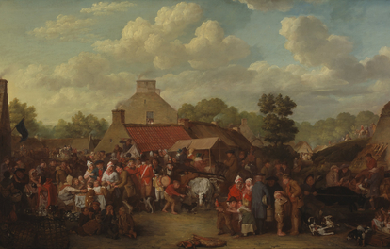
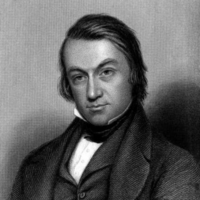
Charles Mackay (27 March 1814– 24 December 1889) was a Scottish poet, journalist, author, anthologist, novelist, and songwriter, remembered mainly for his book Extraordinary Popular Delusions and the Madness of Crowds. He was born in Perth. His father, George Mackay, was a bombardier in the Royal Artillery, and his mother Amelia Cargill died shortly after his birth. His birthdate was 26 March 1812, although he always gave it as 27 March 1814.
Environmental scientist and maybe a poet. I suspect like most people on here I have an urge to write. I've been much buoyed by kind words and likes over the years on this site, despite been in the weeds and not writing for the past few. Now I have my head above the water I can hear my muse again. Thank you kindly for stopping by. I love reading work by others at all stages of their writing journey. Bon Voyage!
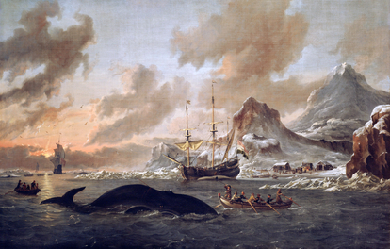
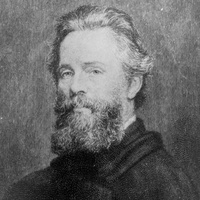
Herman Melville (August 1, 1819– September 28, 1891) was an American novelist, short story writer, and poet of the American Renaissance period best known for Typee (1846), a romantic account of his experiences in Polynesian life, and his whaling novel Moby-Dick (1851). His work was almost forgotten during his last thirty years. His writing draws on his experience at sea as a common sailor, exploration of literature and philosophy, and engagement in the contradictions of American society in a period of rapid change. He developed a complex, baroque style: the vocabulary is rich and original, a strong sense of rhythm infuses the elaborate sentences, the imagery is often mystical or ironic, and the abundance of allusion extends to Scripture, myth, philosophy, literature, and the visual arts.

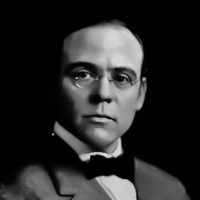
Edgar Lee Masters (August 23, 1868– March 5, 1950) was an American attorney, poet, biographer, and dramatist. He is the author of Spoon River Anthology, The New Star Chamber and Other Essays, Songs and Satires, The Great Valley, The Serpent in the Wilderness An Obscure Tale, The Spleen, Mark Twain: A Portrait, Lincoln: The Man, and Illinois Poems. In all, Masters published twelve plays, twenty-one books of poetry, six novels and six biographies, including those of Abraham Lincoln, Mark Twain, Vachel Lindsay, and Walt Whitman. Life and career Born in Garnett, Kansas to attorney Hardin Wallace Masters and Emma J. Dexter, his father had briefly moved to set up a law practice, then soon moved back to his paternal grandparents’ farm near Petersburg in Menard County, Illinois. In 1880 they moved to Lewistown, Illinois, where he attended high school and had his first publication in the Chicago Daily News. The culture around Lewistown, in addition to the town’s cemetery at Oak Hill, and the nearby Spoon River were the inspirations for many of his works, most notably Spoon River Anthology, his most famous and acclaimed work. He attended Knox Academy in 1889–90, a now defunct preparatory program run by Knox College, but was forced to leave due to his family’s inability to finance his education. After working in his father’s law office, he was admitted to the Illinois bar and moved to Chicago, where he established a law partnership in 1893 with the law firm of Kickham Scanlan. He married twice. In 1898 he married Helen M. Jenkins, the daughter of Robert Edwin Jenkins, a lawyer in Chicago, and had three children. During his law partnership with Clarence Darrow from 1903 to 1908, Masters defended the poor. In 1911 he started his own law firm, despite three years of unrest (1908–11) caused by extramarital affairs and an argument with Darrow. Two of his children followed him with literary careers. His daughter Marcia pursued poetry, while his son Hilary Masters became a novelist. Hilary and his half-brother Hardin wrote a memoir of their father. Masters died at a nursing home on March 5, 1950, in Melrose Park, Pennsylvania, age 81. He is buried in Oakland cemetery in Petersburg, Illinois. His epitaph includes his poem, “To-morrow is My Birthday” from Toward the Gulf (1918): Good friends, let’s to the fields…After a little walk and by your pardon, I think I’ll sleep, there is no sweeter thing.Nor fate more blessed than to sleep. I am a dream out of a blessed sleep-Let’s walk, and hear the lark. Family history Edgar’s father was Hardin Wallace Masters, whose father was Squire Davis Masters, whose father was Thomas Masters, whose father was Hillery Masters, the son of Robert Masters (born c. 1715, Prince George’s County, Maryland, the son of William W. Masters and wife Mary Veatch Masters). Edgar Lee Masters wrote in his autobiography, Across Spoon River (1936), that his ancestor Hillery Masters was the son of “Knotteley” Masters, but family genealogies show that Hillery and Notley Masters were, in fact, brothers. Poetry Masters first published his early poems and essays under the pseudonym Dexter Wallace (after his mother’s maiden name and his father’s middle name) until the year 1903, when he joined the law firm of Clarence Darrow. Masters began developing as a notable American poet in 1914, when he began a series of poems (this time under the pseudonym Webster Ford) about his childhood experiences in Western Illinois, which appeared in Reedy’s Mirror, a St. Louis publication. In 1915 the series was bound into a volume and re-titled Spoon River Anthology. Years later, he wrote a memorable and invaluable account of the book’s background and genesis, his working methods and influences, as well as its reception by the critics, favorable and hostile, in an autobiographical article notable for its human warmth and general interest. Although he never matched the success of his Spoon River Anthology, he did publish several other volumes of poems including Book of Verses in 1898, Songs and Sonnets in 1910, The Great Valley in 1916, Song and Satires in 1916, The Open Sea in 1921, The New Spoon River in 1924, Lee in 1926, Jack Kelso in 1928, Lichee Nuts in 1930, Gettysburg, Manila, Acoma in 1930, Godbey, sequel to Jack Kelso in 1931, The Serpent in the Wilderness in 1933, Richmond in 1934, Invisible Landscapes in 1935, The Golden Fleece of California in 1936, Poems of People in 1936, The New World in 1937, More People in 1939, Illinois Poems in 1941, and Along the Illinois in 1942. Lincoln: the Man In 1931 Masters published the biography Lincoln: the Man, which demythologizes Abraham Lincoln, portraying him as a tool of bankers wanting a new Bank of the United States, “that political system which doles favors to the strong in order to win and keep their adherence to the government”, and advocates “a people taxed to make profits for enterprises that cannot stand alone”. He claimed the Whig Party led by Lincoln’s mentor Henry Clay “had no platform to announce because its principles were plunder and nothing else.” Quotations from the book: “The political history of America has been written for the most part by those who were unfriendly to the theory of a confederated republic, or who did not understand it. It has been written by devotees of the protective principle [tariff], by centralists, and to a large degree by New England.” “For in six weeks he was to inaugurate a war without the American people having anything to say about it. He was to call for and send troops into the South, and thus stir that psychology of hate and fear from which a people cannot extricate themselves, though knowing and saying that the war was started by usurpation. Did he mean that he would bow to the American people when the law was laid down by their courts, through which alone the law be interpreted as the Constitutional voice of the people? No, he did not mean that; because when Taney decided that Lincoln had no power to suspend the writ of habeas corpus, Lincoln flouted and trampled the decision of the court.” “The War between the States demonstrated that salvation is not of the Jews, but of the Greeks. The World War added to this proof; for Wilson did many things that Lincoln did, and with Lincoln as authority for doing them. Perhaps it will happen again that a few men, deciding what is a cause of war, and what is necessary to its successful prosecution, may, as Lincoln and Wilson did, seal the lips of discussion and shackle the press; but no less the ideal of a just state, which has founded itself in reason and in free speech, will remain.” Notable works Poetry * A Book of Verses (1898) * Songs and Sonnets (1910) * Spoon River Anthology (1915) * Songs and Satires (1916) * Fiddler Jones (1916) * The Great Valley (New York: Macmillan Co., 1916) * Toward the Gulf (New York: Macmillan Co., 1918) * Starved Rock (New York: Macmillan Co., 1919) * Jack Kelso: A Dramatic Poem (1920) * Domesday Book (New York: Macmillan Co., 1920) * The Open Sea (New York: Macmillan Co., 1921) * The New Spoon River (New York: Macmillan Co., 1924) * Selected Poems (1925) * Lichee-Nut Poems (American Mercury, Jan. 1925) * Lee: A Dramatic Poem (1926) * Godbey: A Dramatic Poem (1931), sequel to Jack Kelso (1920) * The Serpent in the Wilderness (1933) * Richmond: A Dramatic Poem (1934) * Invisible Landscapes (1935) * Poems of People (1936) * The Golden Fleece of California (1936) (poetic narrative) * The New World (1937) * More People (1939) * Illinois Poems (1941) * Along the Illinois (1942) * Silence (1946) * George Gray * Many Soldiers * The Unknown Biographies * Children of the Market Place: A Fictitious Autobiography (New York: Macmillan Co., 1922). Life of Stephen Douglas. * Levy Mayer and the New Industrial Era (New Haven: Yale University Press, 1927). Chicago attorney Levy Mayer (1858-1922). * Lincoln: The Man (1931) * Vachel Lindsay: A Poet in America (1935) * Across Spoon River: An Autobiography (memoir) (1936) * Whitman (1937) * Mark Twain: A Portrait (1938) Books * The New Star Chamber and Other Essays (1904) * The Blood of the Prophets (1905) (play) * Althea (1907) (play) * The Trifler (1908) (play) * Mitch Miller (novel) (1920) * Skeeters Kirby (novel) (1923) * The Nuptial Flight (novel) (1923) * Kit O’Brien (novel) (1927) * The Fate of the Jury: An Epilogue to Domesday Book (1929) * Gettysburg, Manila, Acoma: Three Plays (1930) * The Tale of Chicago (1933) * The Tide of Time (novel) (1937) * The Sangamon (Chicago: University of Illinois Press, 1942, 1988) Awards & honors Masters was awarded the Mark Twain Silver Medal in 1936, the Poetry Society of America medal in 1941, the Academy of American Poets Fellowship in 1942, and the Shelly Memorial Award in 1944. In 2014, he was inducted into the Chicago Literary Hall of Fame. References Wikipedia—https://en.wikipedia.org/wiki/Edgar_Lee_Masters

Lucy Maud Montgomery OBE (November 30, 1874– April 24, 1942), publicly known as L. M. Montgomery, was a Canadian author best known for a series of novels beginning in 1908 with Anne of Green Gables. The book was an immediate success. The central character, Anne Shirley, an orphaned girl, made Montgomery famous in her lifetime and gave her an international following. The first novel was followed by a series of sequels with Anne as the central character. Montgomery went on to publish 20 novels as well as 530 short stories, 500 poems, and 30 essays. Most of the novels were set in Prince Edward Island, and locations within Canada’s smallest province became a literary landmark and popular tourist site—namely Green Gables farm, the genesis of Prince Edward Island National Park. She was made an officer of the Order of the British Empire in 1935. Montgomery’s work, diaries and letters have been read and studied by scholars and readers worldwide. Early life Lucy Maud Montgomery was born in Clifton (now New London) in Prince Edward Island on November 30, 1874. Her mother Clara Woolner Macneill Montgomery died of tuberculosis when Maud was 21 months old. Stricken with grief over his wife’s death, Hugh John Montgomery gave custody to Montgomery’s maternal grandparents. Later he moved to Prince Albert, North-West Territories (now Prince Albert, Saskatchewan) when Montgomery was seven. She went to live with her maternal grandparents, Alexander Marquis Macneill and Lucy Woolner Macneill, in the nearby community of Cavendish and was raised by them in a strict and unforgiving manner. Montgomery’s early life in Cavendish was very lonely. Despite having relatives nearby, much of her childhood was spent alone. Montgomery credits this time of her life, in which she created many imaginary friends and worlds to cope with her loneliness, with developing her creativity. Montgomery completed her early education in Cavendish with the exception of one year (1890–1891) during which time she was in Prince Albert with her father and her stepmother, Mary Ann McRae. In November 1890, while in Prince Albert, Montgomery’s first work, a poem entitled “On Cape LeForce,” was published in the Charlottetown paper, The Daily Patriot. She was as excited about this as she was about her return to her beloved Prince Edward Island in 1891. The return to Cavendish was a great relief to her. Her time in Prince Albert was unhappy, for she did not get along with her stepmother and because by, “... Maud’s account, her father’s marriage was not a happy one.” In 1893, following the completion of her grade school education in Cavendish, she attended Prince of Wales College in Charlottetown, and obtained a teacher’s license. She completed the two-year program in one year. In 1895 and 1896, she studied literature at Dalhousie University in Halifax, Nova Scotia. Writing career, romantic interests, and family life Published books and suitors Upon leaving Dalhousie, Montgomery worked as a teacher in various Prince Edward Island schools. Though she did not enjoy teaching, it afforded her time to write. Beginning in 1897, she began to have her short stories published in magazines and newspapers. Montgomery was prolific and had over 100 stories published from 1897 to 1907. During her teaching years, Montgomery had numerous love interests. As a highly fashionable young woman, she enjoyed “slim, good looks” and won the attention of several young men. In 1889, at 14, Montgomery began a relationship with a Cavendish boy named Nate Lockhart. To Montgomery, the relationship was merely a humorous and witty friendship. It ended abruptly when Montgomery refused his marriage proposal. The early 1890s brought unwelcome advances from John A. Mustard and Will Pritchard. Mustard, her teacher, quickly became her suitor; he tried to impress her with his knowledge of religious matters. His best topics of conversation were his thoughts on Predestination and “other dry points of theology”, which held little appeal for Montgomery. During the period when Mustard’s interest became more pronounced, Montgomery found a new interest in Will Pritchard, the brother of her friend Laura Pritchard. This friendship was more amiable but, again, he felt more for Montgomery than she did for him. When Pritchard sought to take their friendship further, Montgomery resisted. Montgomery refused both marriage proposals; the former was too narrow-minded, and the latter was merely a good chum. She ended the period of flirtation when she moved to Prince Edward Island. However, she and Pritchard did continue to correspond for over six years, until Pritchard caught influenza and died in 1897. In 1897, Montgomery accepted the proposal of Edwin Simpson, who was a student in French River near Cavendish. Montgomery wrote that she accepted his proposal out of a desire for “love and protection” and because she felt her prospects were rather low. While teaching in Lower Bedeque, she had a brief but passionate romantic attachment to Herman Leard, a member of the family with which she boarded. In 1898, after much unhappiness and disillusionment, Montgomery broke off her engagement to Simpson. Montgomery no longer sought romantic love. In 1898, Montgomery moved back to Cavendish to live with her widowed grandmother. For a nine-month period between 1901 and 1902, she worked in Halifax as a substitute proofreader for the newspapers Morning Chronicle and The Daily Echo. Montgomery was inspired to write her first books during this time on Prince Edward Island. Until her grandmother’s death in March 1911, Montgomery stayed in Cavendish to take care of her. This coincided with a period of considerable income from her publications. Although she enjoyed this income, she was aware that “marriage was a necessary choice for women in Canada.” Marriage and family In 1908, Montgomery published her first book, Anne of Green Gables. An immediate success, it established Montgomery’s career, and she would write and publish material (Including numerous sequels to Anne) continuously for the rest of her life. Shortly after her grandmother’s death in 1911, she married Ewen (spelled in her notes and letters as “Ewan”) Macdonald (1870–1943), a Presbyterian minister, and they moved to Ontario where he had taken the position of minister of St. Paul’s Presbyterian Church, Leaskdale in present-day Uxbridge Township, also affiliated with the congregation in nearby Zephyr. Montgomery wrote her next eleven books from the Leaskdale manse. The structure was subsequently sold by the congregation and is now the Lucy Maud Montgomery Leaskdale Manse Museum. The Macdonalds had three sons; the second was stillborn. The great increase of Montgomery’s writings in Leaskdale is the result of her need to escape the hardships of real life. Montgomery underwent several periods of depression while trying to cope with the duties of motherhood and church life and with her husband’s attacks of religious melancholia (endogenous major depressive disorder) and deteriorating health: "For a woman who had given the world so much joy, [life] was mostly an unhappy one." For much of her life, writing was her one great solace. Also, during this time, Montgomery was engaged in a series of "acrimonious, expensive, and trying lawsuits with the publisher L.C. Page, that dragged on until she finally won in 1929.” Montgomery stopped writing about Anne in about 1920, writing in her journal that she had tired of the character. She preferred instead to create books about other young, female characters, feeling that her strength was writing about characters who were either very young or very old. Other series written by Montgomery include the “Emily” and “Pat” books, which, while successful, did not reach the same level of public acceptance as the “Anne” volumes. She also wrote a number of stand-alone novels, which were also generally successful, if not as successful as her Anne books. Later life In 1926, the family moved into the Norval Presbyterian Charge, in present-day Halton Hills, Ontario, where today the Lucy Maud Montgomery Memorial Garden can be seen from Highway 7. In 1935, upon her husband’s retirement, Montgomery moved to Swansea, Ontario, a suburb of Toronto, buying a house which she named Journey’s End, situated on Riverside Drive along the east bank of the Humber River. Montgomery continued to write, and (in addition to writing other material) returned to writing about Anne after a 15-year hiatus, filling in previously unexplored gaps in the chronology she had developed for the character. She published Anne of Windy Poplars in 1936 and Anne of Ingleside in 1939. Jane of Lantern Hill, a non-Anne novel, was also composed around this time and published in 1937. In the last year of her life, Montgomery completed what she intended to be a ninth book featuring Anne, titled The Blythes Are Quoted. It included fifteen short stories (many of which were previously published) that she revised to include Anne and her family as mainly peripheral characters; forty-one poems (most of which were previously published) that she attributed to Anne and to her son Walter, who died as a soldier in the Great War; and vignettes featuring the Blythe family members discussing the poems. The book was delivered to Montgomery’s publisher on the day of her death, but for reasons unexplained, the publisher declined to issue the book at the time. Montgomery scholar Benjamin Lefebvre speculates that the book’s dark tone and anti-war message (Anne speaks very bitterly of WWI in one passage) may have made the volume unsuitable to publish in the midst of the second world war. An abridged version of this book, which shortened and reorganized the stories and omitted all the vignettes and all but one of the poems, was published as a collection of short stories called The Road to Yesterday in 1974, more than 30 years after the original work had been submitted. A complete edition of The Blythes Are Quoted, edited by Benjamin Lefebvre, was finally published in its entirety by Viking Canada in October 2009, more than 67 years after it was composed. Death Montgomery died on April 24, 1942. A note was found beside her bed, reading, in part, “I have lost my mind by spells and I do not dare think what I may do in those spells. May God forgive me and I hope everyone else will forgive me even if they cannot understand. My position is too awful to endure and nobody realizes it. What an end to a life in which I tried always to do my best.” Montgomery died from coronary thrombosis in Toronto. However, it was revealed by her granddaughter, Kate Macdonald Butler, in September 2008 that Montgomery suffered from depression– possibly as a result of caring for her mentally ill husband for decades– and may have taken her own life via a drug overdose. But, there is another point of view. According to Mary Rubio, who wrote a biography of Montgomery, Lucy Maud Montgomery: The Gift of Wings (2008), the message may have been intended to be a journal entry as part of a journal that can no longer be found, rather than a simple suicide note. During her lifetime, Montgomery published 20 novels, over 500 short stories, an autobiography, and a book of poetry. Aware of her fame, by 1920 Montgomery began editing and recopying her journals, presenting her life as she wanted it remembered. In doing so certain episodes were changed or omitted. She was buried at the Cavendish Community Cemetery in Cavendish following her wake in the Green Gables farmhouse and funeral in the local Presbyterian church. Legacy Collections The L. M. Montgomery Institute, founded in 1993, at the University of Prince Edward Island, promotes scholarly inquiry into the life, works, culture, and influence of L. M. Montgomery and coordinates most of the research and conferences surrounding her work. The Montgomery Institute collection consists of novels, manuscripts, texts, letters, photographs, sound recordings and artifacts and other Montgomery ephemera. Her major collections are archived at the University of Guelph. The first biography of Montgomery was The Wheel of Things: A Biography of L. M. Montgomery (1975), written by Mollie Gillen. Dr. Gillen also discovered over 40 of Montgomery’s letters to her pen-friend George Boyd MacMillan in Scotland and used them as the basis for her work. Beginning in the 1980s, her complete journals, edited by Mary Rubio and Elizabeth Waterston, were published by the Oxford University Press. From 1988–95, editor Rea Wilmshurst collected and published numerous short stories by Montgomery. Most of her essays, along with interviews with Montgomery, commentary on her work, and coverage of her death and funeral, appear in Benjamin Lefebvre’s The L. M. Montgomery Reader, Volume 1: A Life in Print (2013). Despite the fact that Montgomery published over twenty books, “she never felt she achieved her one 'great’ book”. Her readership, however, has always found her characters and stories to be among the best in fiction. Mark Twain said Montgomery’s Anne was “the dearest and most moving and delightful child since the immortal Alice". Montgomery was honoured by being the first female in Canada to be named a fellow of the Royal Society of Arts in England and by being invested in the Order of the British Empire in 1935. However, her fame was not limited to Canadian audiences. Anne of Green Gables became a success worldwide. For example, every year, thousands of Japanese tourists “make a pilgrimage to a green-gabled Victorian farmhouse in the town of Cavendish on Prince Edward Island”. In 2012, the original novel Anne of Green Gables was ranked number nine among all-time best children’s novels in a survey published by School Library Journal, a monthly with primarily U.S. audience. The British public ranked it number 41 among all novels in The Big Read, a 2003 BBC survey to determine the “nation’s best-loved novel”. Landmarked places Montgomery’s home of Leaskdale Manse in Ontario, and the area surrounding Green Gables and her Cavendish home in Prince Edward Island, have both been designated National Historic Sites. Montgomery herself was designated a Person of National Historic Significance by the Government of Canada in 1943. Bala’s Museum in Bala, Ontario, is a house museum established in 1992. Officially it is “Bala’s Museum with Memories of Lucy Maud Montgomery”, for Montgomery and her family stayed in the boarding house during a July 1922 holiday that inspired her novel The Blue Castle (1926). The museum hosts some events pertaining to Montgomery or her fiction, including re-enactment of the holiday visit. Honours and awards Montgomery was honoured by Britain’s King George V as an Officer of the Order of the British Empire (OBE), as there were no Canadian orders, decorations or medals for civilians until the 1970s. Montgomery was named a National Historic Person in 1943 by the Canadian federal government. Her Ontario residence was designated a National Historic Site (NHS) in 1997 (Leaskdale Manse NHS), while the place that inspired her famous novels, Green Gables, was designated “L. M. Montgomery’s Cavendish NHS” in 2004. On May 15, 1975, the Post Office Department issued a stamp to “Lucy Maud Montgomery, Anne of Green Gables” designed by Peter Swan and typographed by Bernard N. J. Reilander. The 8¢ stamps are perforated 13 and were printed by Ashton-Potter Limited. A pair of stamps was issued in 2008 by Canada Post, marking the centennial of the publication of Montgomery’s classic first novel. The City of Toronto named a park for her (Lucy Maud Montgomery Park) and in 1983 placed a historical marker there near the house where she lived from 1935 until her death in 1942. On November 30, 2015 (her 141st birthday), Google honoured Lucy Maud Montgomery with a Google Doodle published in twelve countries.
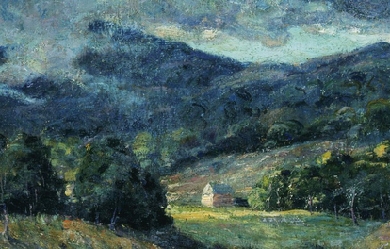
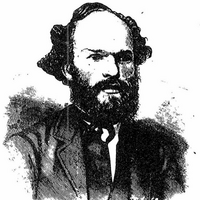
James McIntyre (baptised 25 May 1828– 31 March 1906), called The Cheese Poet, was a Canadian poet. McIntyre was born in Forres, Scotland and came to Canada in 1841 at the age of 14. He worked as a hired hand to begin with, performing pioneer chores that formed the basis of a number of his works. Later, he settled in St. Catharines, Ontario, where he dealt in furniture. There he married and had a daughter and son. He later moved to Ingersoll, Ontario, then a town of 5,000 on the banks of the Thames in Oxford County, the heart of Canadian dairy country at the time. He opened a furniture factory on the river as well as a store which sold furniture, along with such items as pianos and coffins. He was well loved in the community, from which he often received aid in hard times, due in part to his poesy and oratorical skills—he was called on to speak at every kind of social gathering in Ingersoll. The region seems to have inspired him, and it was in celebration of the proud history of Canada, the natural beauty and industry of the region, and especially (as noted above) its cheese, that the majority of his oeuvre was written. The ancient poets ne’er did dream That Canada was land of cream, They ne’er imagined it could flow In this cold land of ice and snow, Where everything did solid freeze They ne’er hoped or looked for cheese. from “Oxford Cheese Ode” [1] McIntyre was uninhibited by minor shortcomings—such as his lack of literary skills. The Toronto Globe ran his pieces as comic relief, and the New York Tribune expressed amusement, but their mockery did not dampen his enthusiasm. He is assumed to have continued writing until his death, in 1906. He published two volumes of poetry: Musings on the Canadian Thames (1884); Poems of James McIntyre (1889). McIntyre was forgotten after his death for a number of years, until his work was rediscovered and reprinted by William Arthur Deacon—literary editor of the Toronto Mail and Empire and its successor the Globe and Mail—in his book The Four Jameses (1927). In recent years a volume of his work, Oh! Queen of Cheese: Selections from James McIntyre, the Cheese Poet (ed. Roy A Abramson; Toronto: Cherry Tree, 1979) collected his poems together with a variety of cheese recipes and anecdotes. However, the greatest boost to his fame probably came from a number of his poems being anthologized in the collection Very Bad Poetry, edited by Ross and Kathryn Petras (Vintage, 1997). This included his masterpiece and possibly best-known poem, "Ode on the Mammoth Cheese Weighing Over 7,000 Pounds," written about an actual cheese produced in Ingersoll in 1866 and sent to exhibitions in Toronto, New York, and Britain: We have seen thee, Queen of Cheese, Lying quietly at your ease, Gently fanned by evening breeze; Thy fair form no flies dare seize. All gaily dressed, soon you’ll go To the provincial show, To be admired by many a beau In the city of Toronto. from “Ode on the Mammoth Cheese” [2] An annual poetry contest is held in Ingersoll, Ontario, to honour McIntyre. The contest is sponsored by The Ingersoll Times and the Corporation of the Town of Ingersoll, and includes a cheese-themed poetry competition. References Wikipedia—https://en.wikipedia.org/wiki/James_McIntyre_(poet)

I write poetry. It's my entire life, pretty much. Part of me wants to delete all of this, because most of it is childish and stupid. There is a part of me though that kinda wants to hang on to some of it cause it's part of my history. I no longer have physical copies of any of these, and if I delete it without copying it it'll just be gone. No editing; no rewrites; no revisions. Just gone. Never to return again. What should I do?
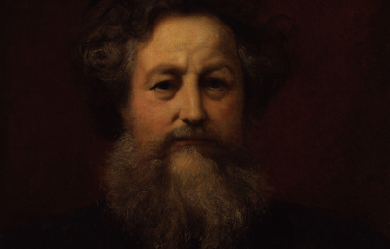
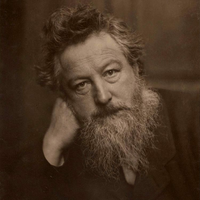
William Morris (24 March 1834– 3 October 1896) was an English textile designer, poet, novelist, translator, and socialist activist. Associated with the British Arts and Crafts Movement, he was a major contributor to the revival of traditional British textile arts and methods of production. His literary contributions helped to establish the modern fantasy genre, while he played a significant role in propagating the early socialist movement in Britain.
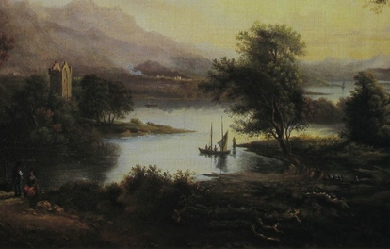
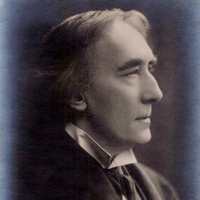
William Topaz McGonagall (March 1825 – 29 September 1902) was a Scottish weaver, doggerel poet and actor. He won notoriety as an extremely bad poet who exhibited no recognition of, or concern for, his peers' opinions of his work. He wrote about 200 poems, including his notorious "The Tay Bridge Disaster" and "The Famous Tay Whale", which are widely regarded as some of the worst in English literature. Groups throughout Scotland engaged him to make recitations from his work and contemporary descriptions of these performances indicate that many listeners were appreciating McGonagall's skill as a comic music hall character. Collections of his verse remain popular, with several volumes available today. McGonagall has been acclaimed as the worst poet in British history. The chief criticisms are that he is deaf to poetic metaphor and unable to scan correctly. McGonagall's fame stems from the humorous effects these shortcomings generate in his work. The inappropriate rhythms, weak vocabulary, and ill-advised imagery combine to make his work amongst the most unintentionally amusing dramatic poetry in the English language. His work is in a long tradition of narrative ballads and verse written and published about great events and tragedies, and widely circulated among the local population as handbills. In an age before radio and television, their voice was one way of communicating important news to an avid public. References Wikipedia—https://en.wikipedia.org/wiki/William_McGonagall
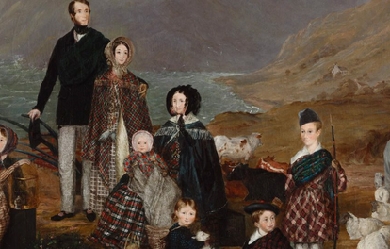
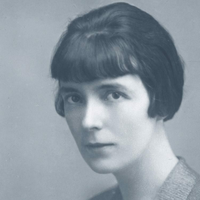
Kathleen Mansfield Murry (14 October 1888– 9 January 1923) was a prominent New Zealand modernist short story writer who was born and brought up in colonial New Zealand and wrote under the pen name of Katherine Mansfield. At 19, Mansfield left New Zealand and settled in the United Kingdom, where she became a friend of modernist writers such as D.H. Lawrence and Virginia Woolf. In 1917 she was diagnosed with extrapulmonary tuberculosis, which led to her death at the age of 34. Biography Early life Mansfield was born Kathleen Mansfield Beauchamp in 1888 into a socially prominent family in Wellington, New Zealand. Her father was a banker and she was a cousin of the author Countess Elizabeth von Arnim. She had two older sisters, a younger sister and a younger brother, born in 1894. Her father, Harold Beauchamp, became the chairman of the Bank of New Zealand and was knighted. Her grandfather was Arthur Beauchamp, who briefly represented the Picton electorate in Parliament. In 1893 the Mansfield family moved from Thorndon to Karori, where Mansfield spent the happiest years of her childhood. She used some of her memories of this time as an inspiration for the “Prelude” story. Her first published stories appeared in the High School Reporter and the Wellington Girls’ High School magazine (the family returned to Wellington proper in 1898), in 1898 and 1899. In 1902 she became enamoured of a cellist, Arnold Trowell, although the feelings were largely unreciprocated. Mansfield herself was an accomplished cellist, having received lessons from Trowell’s father. Mansfield wrote in her journals of feeling alienated in New Zealand, and of how she had become disillusioned because of the repression of the Māori people. Māori characters are often portrayed in a sympathetic or positive light in her later stories, such as “How Pearl Button Was Kidnapped”. In 1903 she moved to London, where she attended Queen’s College along with her sisters. Mansfield recommenced playing the cello, an occupation that she believed she would take up professionally, but she also began contributing to the college newspaper with such dedication that she eventually became its editor. She was particularly interested in the works of the French Symbolists and Oscar Wilde, and she was appreciated among her peers for her vivacious and charismatic approach to life and work. She met fellow writer Ida Baker (also known as Lesley Moore), a South African, at the college, and they became lifelong friends. Mansfield did not become involved in much political activity when she lived in London. For example, she did not actively support the suffragette movement in the UK (women in New Zealand had gained the right to vote in 1893). Mansfield travelled in continental Europe between 1903 and 1906, staying mainly in Belgium and Germany. After finishing her schooling in England, she returned to New Zealand in 1906, and only then began to write short stories. She had several works published in the Native Companion (Australia), her first paid writing work, and by this time she had her heart set on becoming a professional writer. It was also the first occasion on which she used the pseudonym “K. Mansfield”. She rapidly wearied of the provincial New Zealand lifestyle and of her family, and two years later headed again for London. Her father sent her an annual allowance of 100 pounds for the rest of her life. In later years she expressed both admiration and disdain for New Zealand in her journals, but she was never able to return there because of her tuberculosis. Mansfield had two romantic relationships with women that are notable for their pre-eminence in her journal entries. She continued to have male lovers, and attempted to repress her feelings at certain times. Her first same-gender romantic relationship was with Maata Mahupuku (sometimes known as Martha Grace), a wealthy young Māori woman whom she had first met at Miss Swainson’s school in Wellington, and then again in London in 1906. In June 1907 she wrote: “I want Maata—I want her as I have had her—terribly. This is unclean I know but true.” She often referred to Maata as Carlotta. She wrote about Maata in several short stories. Maata married in 1907 but it is claimed that she sent money to Mansfield in London. The second relationship, with Edith Kathleen Bendall, took place from 1906 to 1908. Mansfield also professed her adoration for her in her journals. Return to London Back in London in 1908, Mansfield quickly fell into a bohemian way of life. She published only one story and one poem during her first 15 months there. Mansfield sought out the Trowell family for companionship, and while Arnold was involved with another woman Mansfield embarked on a passionate affair with his brother, Garnet. By early 1909 she had become pregnant by Garnet, though Trowell’s parents disapproved of the relationship and the two broke up. She hastily entered into a marriage with George Bowden, a singing teacher 11 years older than she; they were married on 2 March, but she left him the same evening, before the marriage could be consummated. After a brief reunion with Garnet, Mansfield’s mother, Annie Beauchamp, arrived in 1909. She blamed the breakdown of the marriage to Bowden on a lesbian relationship between Mansfield and Baker, and she quickly had her daughter despatched to the spa town of Bad Wörishofen in Bavaria, Germany. Mansfield miscarried after attempting to lift a suitcase on top of a cupboard. It is not known whether her mother knew of this miscarriage when she left shortly after arriving in Germany, but she cut Mansfield out of her will. Mansfield’s time in Bavaria had a significant effect on her literary outlook. In particular, she was introduced to the works of Anton Chekhov. She returned to London in January 1910. She then published more than a dozen articles in A.R. Orage’s socialist magazine The New Age, and became a friend and lover of Beatrice Hastings, who lived with Orage. Her experiences of Germany formed the foundation of her first published collection, In a German Pension, (1911), which she later described as “immature”. Meeting Murry Soon afterwards Mansfield submitted a lightweight story to a new avant-garde magazine called Rhythm. The piece was rejected by the magazine’s editor, John Middleton Murry, who requested something darker. Mansfield responded with “The Woman at the Store”, a tale of murder and mental illness. Mansfield was inspired at this time by Fauvism. In 1911 Mansfield and Murry began a relationship that culminated in their marriage in 1918, although she left him twice, in 1911 and 1913. In October 1912 the publisher of Rhythm, Charles Granville (sometimes known as Stephen Swift), absconded to Europe and left Murry responsible for the debts the magazine had accumulated. Mansfield pledged her father’s allowance towards the magazine, but it was discontinued, being reorganised as The Blue Review in 1913 and folding after three issues. Mansfield and Murry were persuaded by their friend Gilbert Cannan to rent a cottage next to his windmill in Cholesbury, Buckinghamshire in 1913, in an attempt to alleviate Mansfield’s ill health. In January 1914 the couple moved to Paris, in the hope that a change of setting would make writing easier for both of them. Mansfield wrote only one story during her time there ("Something Childish But Very Natural") before Murry was recalled to London to declare bankruptcy. In 1914 Mansfield had a brief affair with the French writer Francis Carco. Her visit to him in Paris in February 1915 is retold in one of her short stories, “An Indiscreet Journey”. Mansfield’s life and work were changed by the death in 1915 of her beloved younger brother, Leslie Heron “Chummie” Beauchamp, as a New Zealand soldier in France. She began to take refuge in nostalgic reminiscences of their childhood in New Zealand. In a poem describing a dream she had shortly after his death, she wrote By the remembered stream my brother stands Waiting for me with berries in his hands... “These are my body. Sister, take and eat.” At the beginning of 1917 Mansfield and Murry separated, although he continued to visit her at her new apartment. Baker, whom Mansfield often called, with a mixture of affection and disdain, her “wife”, moved in with her shortly afterwards. Mansfield entered into her most prolific period of writing after 1916, which began with several stories, including “Mr Reginald Peacock’s Day” and “A Dill Pickle”, being published in The New Age. Woolf and her husband, Leonard, who had recently set up Hogarth Press, approached her for a story, and Mansfield presented “Prelude”, which she had begun writing in 1915 as “The Aloe”. The story depicts a family of New Zealanders moving house. In December 1917 Mansfield was diagnosed with tuberculosis. Rejecting the idea of staying in a sanatorium on the grounds that it would cut her off from writing, she moved abroad to avoid the English winter. She stayed at a half-deserted and cold hotel in Bandol, France, where she became depressed but continued to produce stories, including "Je ne parle pas français". “Bliss”, the story that lent its name to her second collection of stories in 1920, was also published in 1918. Her health continued to deteriorate and she had her first lung haemorrhage in March. By April Mansfield’s divorce from Bowden had been finalised, and she and Murry married, only to part again two weeks later. They came together again, however, and in March 1919 Murry became editor of Athenaeum, for which Mansfield wrote more than 100 book reviews, collected posthumously as Novels and Novelists. During the winter of 1918–19 she and Baker stayed in a villa in San Remo, Italy. Their relationship came under strain during this period, and after she wrote to Murry to express her feelings of depression he stayed over Christmas. Although her relationship with Murry became increasingly distant after 1918 and the two often lived apart, this intervention of his spurred her on, and she wrote “The Man Without a Temperament”, the story of an ill wife and her long-suffering husband. Mansfield followed her first collection of short stories, Bliss (1920), with another collection The Garden Party, published in 1922. Final years Mansfield spent her last years seeking increasingly unorthodox cures for her tuberculosis. In February 1922 she consulted the Russian physician Ivan Manoukhin, whose “revolutionary” treatment, which consisted of bombarding her spleen with X-rays, caused Mansfield to develop heat flashes and numbness in her legs. In October 1922 Mansfield moved to Georges Gurdjieff’s Institute for the Harmonious Development of Man in Fontainebleau, France, where she was put under the care of Olgivanna Lazovitch Hinzenburg (who later married Frank Lloyd Wright). As a guest rather than a pupil of Gurdjieff, Mansfield was not required to take part in the rigorous routine of the Institute, but she spent much of her time there with her mentor, Alfred Richard Orage and her last letters inform Murry of her attempts to apply some of Gurdjieff’s teachings to her own life. Mansfield suffered a fatal pulmonary haemorrhage in January 1923, after running up a flight of stairs. She died on 9 January and was buried in a cemetery in Avon. Mansfield was a prolific writer in the final years of her life. Much of her work remained unpublished at her death, and Murry took on the task of editing and publishing it in two additional volumes of short stories (The Dove’s Nest in 1923 and Something Childish in 1924), a volume of Poems, The Aloe, Novels and Novelists, and collections of her letters and journals. Legacy The following high schools in New Zealand have a house named after her: Rangitoto College, Westlake Girls’ High School, Macleans College all in Auckland, Tauranga Girls’ College in Tauranga, Wellington Girls’ College in Wellington, Rangiora High School in North Canterbury and Southland Girls’ High School in Invercargill. She has been honoured at Karori Normal School in Wellington which has a stone monument dedicated to her with a plaque commemorating her work and her time at the school. She has also been recognised at Samuel Marsden Collegiate School (previously Fitzherbert Tce School) with a painting and award in her name. There is a Park dedicated to her in Thorndon, Wellington. A street in Menton, France, where she lived and wrote, is named after her and a Fellowship is offered annually to enable a New Zealand writer to work at her former home, the Villa Isola Bella. New Zealand’s pre-eminent short story competition is also named in her honour. She was the subject of the 1973 BBC miniseries A Picture of Katherine Mansfield starring Vanessa Redgrave. The six-part series included adaptations of Mansfield’s life and of her short stories. In 2011, a biopic film titled “Bliss”, was made of her early beginnings as a writer in New Zealand, played by Kate Elliott and featured on the TVNZ TV-movie series “Sunday Theatre” that aired on 28 August 2011.

My name is Victoria Rachelle and I'm 15 years old. Poetry is a way to get rid of the pain i feel inside my heart every day. It understands me and does not judge me. I can rely on it to always be there for me when i have no one else. Yes, my poetry may be a little dark but it only shows what and how i honestly feel inside. I have been through a lot of stuff in the past few years and poetry has helped me though it when i didnt think i could get through life anymore. Everyone has their own opinions on life and these are mine. Judge them as you wish but remember that i may not be the only one with that opinion.


